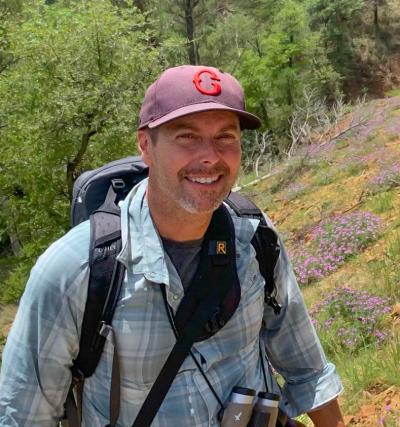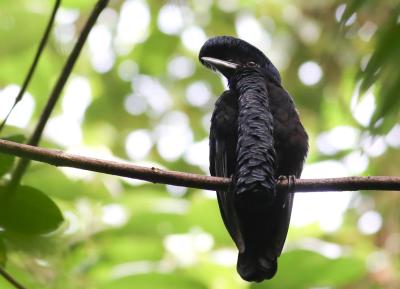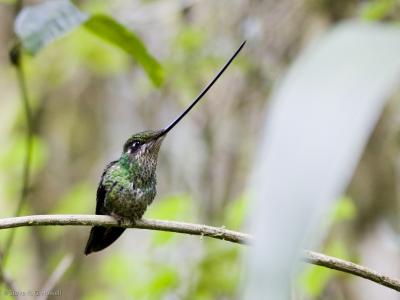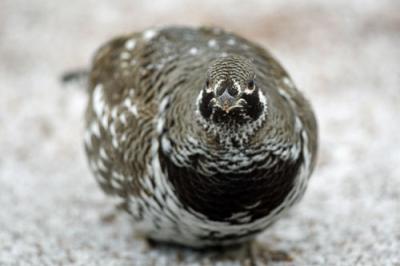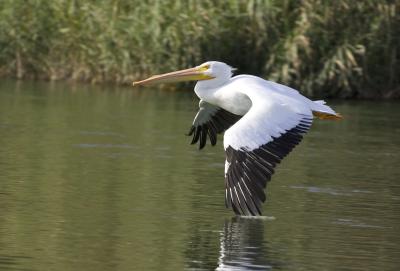Texas: The Upper Coast
-
Apr 17-24, 2025
Jon Feenstra
There may be no better birdwatching in North America than what one may encounter on the northwestern shores of the Gulf of Mexico in spring.
Between mid-March and mid-May, masses of passerines wing north from their wintering grounds and a significant percentage of them pass through this corridor. Add to this both migrant and resident waterbirds including large numbers of herons and spoonbills, shorebirds of 30 or more species, and a profusion of gulls and terns, and it’s no wonder this area is as famous as it is.
Less predictable is what the weather can do to this migration pipeline. If the weather is fair or the winds blow from the south, the countless thousands of migrant thrushes, vireos, warblers and buntings that reach the coast after completing their lengthy trans-Gulf of Mexico migration move along and disperse among the more suitable forests in the interior. But, if they encounter rain or strong north winds before or as they reach the coast, large numbers may drop into the first isolated clumps of vegetation. Called a “fall out,” this phenomenon constitutes one of the great visible migration spectacles in North America and if it occurs during our stay, we’ll alter plans if necessary to bear witness.
Though the migrants alone would draw birdwatchers to this area, the area is rich in resident bird life, as well: nearby pine woods and cypress swamps are home to some of North America’s most sought-after breeding birds. Texas in April is simply full of birds.
Day 1: The tour begins this evening with a 6 pm meeting at our hotel near George Bush Intercontinental Airport, Houston. Night in Houston.
Day 2 – Leaving Houston we’ll stop in a small woodlot that has a few breeding pairs of Red-cockaded Woodpeckers and their fellow North American endemic Brown-headed Nuthatch. We’ll continue toward Jasper, Texas, and the Angelina National Forest for a night stopping along the way at some parks for breeding birds that we may not find on the coast such as Red-headed Woodpecker, Yellow-throated and White-eyed Vireos, Northern Parula, and Yellow-throated, Prothonotary, Swainson’s, Worm-eating and Kentucky Warblers among others. Once in the Jasper area, we may stop at Boykin Springs for Louisiana Waterthrush and along the forest edge for breeding Prairie Warblers (a local breeder in east Texas). While at the parks and along the drive we’ll watch the skies for Red-shouldered and Broad-winged Hawks and Mississippi Kites. We sometimes see a Swallow-tailed Kite, too. Night in Jasper.
Days 3-6: After searching for Bachman’s Sparrows in Angelina National Forest early this morning when their lovely song makes them easier to find, and perhaps do a bit more searching for warblers, we’ll leave the Jasper area for Winnie, our base for explorations of the Upper Texas and Louisiana coasts. These days will be varied and, we hope, spectacular. The central focus will be Sabine Woods and High Island, celebrated land bird migrant traps but ones that require special weather to produce a major fall-out of birds. If we’re lucky, cuckoos, thrushes, vireos, warblers of 25 or more species, tanagers, buntings, and orioles will fill these small woods and provide a memorable birdwatching experience.
As High Island and Sabine Woods tend to have more migrants in the afternoon, we’ll spend several mornings looking at water birds. The heronry at nearby Smith Oaks offers intimate looks at nesting Roseate Spoonbill, Snowy and Great Egrets; mudflats and beaches can hold thousands of herons, gulls, terns, and shorebirds of up to 20 species including Piping and Wilson’s Plovers, often American Oystercatcher, and sometimes thousands of brilliant American Avocets. Flooded rice fields near Winnie can host large numbers of shorebirds, including American Golden-Plover and Pectoral Sandpiper, often joined by Buff-breasted Sandpipers and sometimes White-rumped Sandpiper and Hudsonian Godwit. The wonderful marshes at Anahuac National Wildlife Refuge are recovering from the hurricanes in 2017, and are home to both Fulvous and Black-bellied Whistling-Ducks, Least Bittern, White-faced Ibis, Clapper and King Rails, and Purple Gallinule. There are a few small woodland patches around the marsh that can be good for migrant landbirds.
On one day we’ll visit Cameron Parish in southwestern Louisiana to Johnson’s Bayou and a normally uncrowded Baton Rouge Audubon Society woodlot that captures migrants in the same way as High Island and Sabine Woods. On another day we will drive the coast of the Bolivar Peninsula, stopping in marshes and at beaches to sift through gulls, terns, and shorebirds, as well as look for coastal specialties like Nelson’s and Seaside Sparrows and scan the skies for hunting White-tailed Kites. Nights in Winnie.
Day 7: After a final full day in the field on the Upper Texas Coast, we’ll return to Houston via the Trinity River bottoms where we sometimes find a Swallow-tailed Kite. Night in Houston.
Day 8: The tour concludes this morning in Houston.
Note: The information presented below has been extracted from our formal General Information for this tour. It covers topics we feel potential registrants may wish to consider before booking space. The complete General Information for this tour will be sent to all tour registrants and of course supplemental information, if needed, is available from the WINGS office.
ENTERING THE UNITED STATES: Non-U.S. citizens will need a valid passport and may need a tourist visa. Consult your nearest U.S. Embassy or consulate for details.
PACE OF THE TOUR: Days will be full, with departures usually around 5:30 to 6 AM and returning to the hotel usually by 8:00 p.m. after a group dinner. Although we spend much time on foot, our walks are at a leisurely pace and on flat terrain, so not at all strenuous. The one possible exception is the walk for Yellow Rails conducted by staff or associates of Anahuac National Wildlife Refuge. This walk is strenuous, walking through up to knee-high grass over irregilar and sometimes wet terrain. Some choose to watch from the sidelines and often get identifiable views of Yellow Rail in flight. However, this walk has been discontinued as of 2017. The WINGS office will pass along news if the walk has been revived.
HEALTH: East Texas presents no real hazards to the visiting birdwatcher.
Insects: East Texas has mosquitoes, ticks, and chiggers, though the latter two are infrequently encountered. We recommend using insect repellents with a high concentration of DEET.
Fire ants are widely distributed and noxious. The leaders will identify the ants at first encounter and remind you frequently to watch where you stand.
Zika: This virus is expanding northward from tropical South America into the northern Caribbean and southern United States and health authorities are still trying to gage its full impact. Couples who expect/hope to become pregnant should consult their physician. The virus is transmitted by mosquitos of the genus Aedes, a day-flying mosquito typically found near people in crowded urban environments that have only a minimum of public services like sanitation, window screens, and drainage; in other words locations that aren’t on most tour itineraries.
Smoking: Smoking is prohibited in the vehicles or when the group is gathered for meals, checklists, etc. While in the field or traveling, use of a smokeless alternative such as nicotine gum is requested. Please do not smoke at short stops while traveling. If you smoke in the field, do so well away and downwind from the group and leave ample time between smoking and getting back into the vehicle. If you are sharing a room with a non-smoker, please do not smoke in the room. If any lodge, accommodation or location where the group is staying or is gathered has a more restrictive smoking policy than WINGS’ policy, the more restrictive policy will prevail. The leader reserves the right to modify this policy if the situation warrants it.
Miscellaneous: In April the sun can be intense. A broad-brimmed hat, proper clothing and strong sun screen lotion are essential.
As it may be difficult to replenish supplies of personal medications, please anticipate your needs and bring an adequate supply.
CLIMATE: April is variable in East Texas. It is often humid and temperatures may rise into the high 80s (F) or drop into the high 40s (F) after passage of a cold front. Rain occurs periodically with the passage of fronts but in some years it remains dry.
ACCOMMODATIONS: We stay in standard, comfortable hotels. Wireless Internet is available throughout.
FOOD: Food on the tour is U.S. standard with some good seafood options. Most lunches will be picnics. WINGS tours are all-inclusive and no refunds are available for missed meals.
Food Allergies / Requirements: We cannot guarantee that all food allergies can be accommodated at every destination. Participants with significant food allergies or special dietary requirements should bring appropriate foods with them for those times when their needs cannot be met. Announced meal times are always approximate depending on how the day unfolds. Participants who need to eat according to a fixed schedule should bring supplemental food. Please contact the WINGS office if you have any questions.
TRANSPORTATION: We will be traveling by 15- (or 12) passenger window van or minivan, depending on the group size. When using 15-passenger window vans, we take a maximum of seven passengers plus the leader. Participants should be able to ride in any seat in tour vehicles.
2024 Narrative
There is always good, easy birding in eastern Texas. We started in the interior forests where we found Red-cockaded Woodpecker, Brown-headed Nuthatch, and Bachman’s Sparrows at the western limit of their ranges. Then we went to the coast. The fly-way is there, and the coastal forests can catch those birds migrating north from their wintering haunts in Central and South America… when the wind blows in the right direction. And, on a couple of our days, the wind was blowing just the way we wanted it to: from the north. The forests were alive with birds, a lot of warblers, including Kentucky, Golden-winged, Prothonotary, Cerulean, Bay-breasted, Blackpoll, and others adding up to a nice twenty-four species. We also had flocks of Indigo and Painted Buntings, lots of Scarlet and Summer Tanagers, and a steady stream of Yellow-billed Cuckoos. The grasslands had Upland Sandpipers, the marshes had Purple Gallinules, and everywhere was just plain, good birding fun.
To kick it off, our first day out we left Houston but didn’t leave Houston immediately. In the northern suburbs, surrounded by houses and highways, lies a woodlot in which we got the first of the major specialties of the region. We saw a pair of Red-cockaded Woodpeckers moving between their excavated holes in living pine trees – sap running down keeping ants and whatever away. We also had very accommodating Brown-headed Nuthatches, one posing in the scope for minutes. From there we continued north and east toward the piney woods with an emergency stop for a flock of Mississippi Kites over the highway, grabbing insects on the wing. We also enjoyed a Scissor-tailed Flycatcher on a power line over a busy intersection – we watched it while the light was red. Once we got into bigger woods we encountered some of the classic breeding birds. Northern Parulas were singing away and we had a scope view of one doing its thing. A bright male Summer Tanager worked some branches right over our heads while we had our picnic lunch. And, a spectacular Prothonotary Warbler appeared to be taking a break from its typical marshy thickets to poke around in some branches right in front of us. The breeding birds of east Texas were in good form and a nice start to the trip.
The day began in the recently burned (actually, still burning) piney woods of Angelina National Forest. This managed forest is the western range of Bachman’s Sparrow and we were treated to a long solo of a bird perched up on a bush. Meanwhile, two male Indigo Buntings were singing and trying to distract us from this special bird. We were distracted. From this morning in the piney woods, we undertook the drive to the coast almost taking out a Greater Roadrunner that blasted across the highway right in front of us. Fortunately, it was a good flyer, too, and made it safely to the other side. Mid-day we birded a wetland complex full of Purple Gallinules among Common Gallinules, White-faced Ibis, and American Alligators. Once on the coast, we walked some wetlands and mudflats, though the highlights were less the shorebirds (though, the Wilson’s and Snowy Plovers were nice) and instead the Common Nighthawk asleep next to the parking lot and the bright Dickcissel perched atop a small tree. The drive to our base in Winnie was interrupted by just another alligator in the road.
In the middle of the night when the wind changed from south (from which it has been blowing for a week) to north, birders far and wide got goosebumps and knew that it was time for the coast. The southerly winds had been moving birds right over the gulf and up inland, but fighting those northerlies was going to make the coastal woodlands look like a very nice place to stop. That said, we started in High Island at dawn. There were pewees and Indigo Buntings around, many of each. Then we saw our first warbler a Worm-eating Warbler, then a Bay-breasted, and then, the tap was open and we saw more and more. There were thrushes and vireos and gaudy Painted Buntings and a Yellow-billed Cuckoo or two. We barely moved in about two hours. But, eventually, we tore ourselves away and took a quick break to check on some things on the Bolivar Peninsula. Shorebirds and terns were pretty good, and a lingering Chestnut-collared Longspur was even better, but for shear charisma, the award went to a pair of Scissor-tailed Flycatchers hunting and having their streaming tails blown around in the wind. In the afternoon we went east to Sabine Pass and the woodlot there. There were easily hundreds of birders present, and for good reason, because the woods were hot with birds. The warbler list was formidable but included some sweet birds like Golden-winged Warbler up high, Hooded Warbler down low, and Cerulean Warbler in the middle. We knew we had to have dinner sooner rather than later, but it was hard to pull away.
The next day we picked up where we left off, watching birds bubble in the trees at Sabine Woods. A lot of the same birds were still around, but a lot of new ones had arrived or were in the process of arriving. That morning, but over the whole day, we saw dozens of Yellow-billed Cuckoos. Some were on the move, like all the ones we saw flying across the roads. Others were settling into the forest and resting. We saw them on the ground, in the trees, on fence wires, and even eating huge juicy caterpillars. Warblers were still the stars of the show, with abundant Blackpoll Warblers, generally a scarce migrant along the upper Texas coast. We also saw our first Blue-winged Warblers and finally got good looks at Kentucky Warblers. After Sabine Woods, we returned to High Island and visited the Smith Oak Sanctuary and its spectacular heron rookery. The bubbling sounds of hundreds of nesting Snowy Egrets were bizarre and amazing. Great Egrets had gawky chicks and the Neotropic Cormorants chicks were just getting past their gawkiest. The Yellow-billed Cuckoo show continued here, too, but we were also treated to a very cooperative and generally rare Black-billed Cuckoo. Walking through the woods was to be with the thrushes, but an American Redstart hopping around in some low sticks fanning its fancy tail was a highlight. It was a busy birding day and was bountifully rewarded at its end by a mountain of Cajun food.
South winds all night blew the migrants out of the coastal woodlands, so our foray to the cheniers of Louisiana wasn’t as productive as the previous two days, but there were still birds to look at. We got some looks at a Chuck-wills-widow when one flushed, and a Painted Bunting was singing from a treetop. At lunch, we found our first Philadelphia Vireo of the trip, something of a surprise given how few birds were around today relative to yesterday. The big haul of birds today, though, was out on the Bolivar Peninsula. We started with Seaside Sparrows in the salt grass, watching them sing from the marsh. We then moved out onto the legendary Bolivar Flats that held thousands of shorebirds and terns. Reddish Egrets were dancing around madly in the shallows. Piping Plovers were poking around in the wrack. A Yellow-crowned Night-Heron nailed a frog while its blond plume blew in the breeze. Meanwhile, over a thousand American Avocets waded off the flats, and hundreds of Black, Least, Royal, Common, and Forster’s Terns rested on the sand or foraged along the shore. It was system overload and a great end to the day.
Wrapping up the trip is a slow event, that starts with birding, continues with birding, and works a drive into Houston in there somewhere. We began with Anahuac National Wildlife Refuge, actually the road to the refuge where we were treated to lots of Upland Sandpipers, lots of singing Dickcissels, and a pair of Northern Bobwhite right along the road. When we finally got to Anahuac, among other things, we drove the famous loop road through the marsh. It was bubbling with birds and the air was full of the roars of displaying American Alligators. Shorebirds were showing well with plenty of birds in their breeding plumage including dozens of Stilt Sandpipers. At one point, a Least Bittern flew right in front of the van, landed in some reeds, and sat in the open for several minutes while we watched. After that, we made a lot of farm field drives and short little stops to check interesting whatnots and see the spider lilies. A tree full of Crested Caracaras was pretty cool. There were Scissor-tailed Flycatchers here and there along the road, and our last stop had more Upland Sandpipers. Our final push was through traffic back into Houston for a final dinner and the recap of fun stories from the road.
Maximum group size seven with one leader.























































